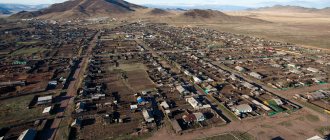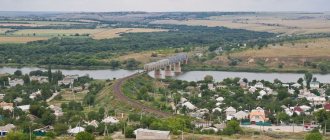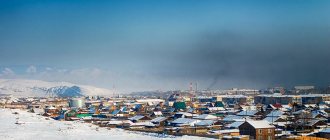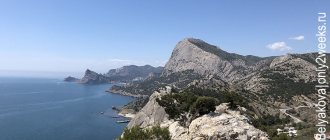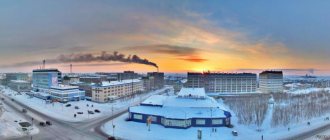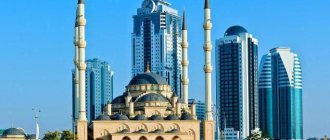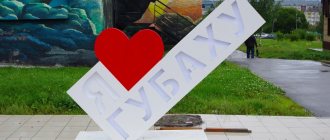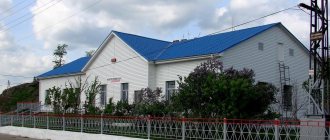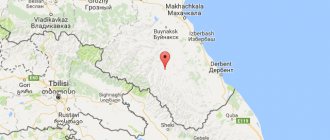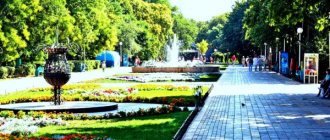Makhachkala is the third largest city in the North Caucasus (and the first of the cities in the North Caucasus Federal District of Russia). Over 700 thousand people live here. Residents of the republic are proud of their city, considering it the most beautiful in the world. And a person coming from the capital will be amazed by Makhachkala with its unusual architecture and shocked by the way of life of its inhabitants. There is no need to think that Makhachkala is a wild settlement, littered with garbage and patrolled by the military around the clock. This is a city that bears little resemblance to the settlements of central Russia, but is quite modern and developing.
Over the past 10 years, the city's population has grown by almost a third. The increase occurs both naturally and through migration. Planning three or more children is the norm in urban families, because most of them are Muslims with traditional views on family. In addition, the city is a center of attraction for many residents of the North Caucasus seeking to move away from the countryside. The residents themselves note that there are few native townspeople left in Makhachkala (many have moved to central Russia), and the city’s population mainly consists of visitors from the village.
The city of Makhachkala was founded in 1844 as a port and military fortification. Since then, Makhachkala has changed its name three times. It was founded under the name Petrovskoye (in honor of Peter the Great); in 1918, the settlement was renamed in honor of Shamil, the leader of the highlanders in the war against Russia. And finally, after the October Revolution, Makhachkala received its modern name. The name was given to her by the Caucasian revolutionary Makhach Dakhadayev. At the same time, the city received the status of the capital of Dagestan.
Modern Makhachkala is called one of the fastest growing cities in Russia. The capital of Dagestan is growing, annexing nearby villages and towns. The mayor sees tourism potential in it and strives to develop this area, and therefore the administration has many plans for the construction of appropriate infrastructure in the city. One of the nearest plans is to improve the beach area. It is also planned to restore historical buildings in the city. The tourist attractiveness of the city is contributed by the amazing Caucasian nature, the geography of the city (on the shores of the Caspian Sea), its bright national color and architectural originality.
City by the warm sea
The climate of Makhachkala is determined by its geographical location: the temperature, cloudiness and winds are significantly influenced by the Caspian Sea.
The city has high levels of humidity and often strong winds, especially during the cold season. Judging by the average annual temperatures, the winter here is noticeably milder than in central Russia: from 0 to -5C.
Frosts are rare, and the thermometer does not fall below -20C, and such frosts occur only a few days a year and are considered almost a natural disaster. According to local residents, this frost is tolerated worse than the same temperatures in the middle zone due to wind and high humidity.
Summer is hot and sunny: the average temperature is about +23C. The warm part of the year lasts from the beginning of May until the first week of October (all this time the temperature stays at least + 11C). It is hot in Makhachkala in July; air temperature +40C is more the norm than a rarity. Therefore, many homes and almost all public places have air conditioners.
If we talk about natural disasters, in Makhachkala these are most often hurricanes. Many residents will remember the terrible wind in 2013, which even blew away gazelle passengers. In the spring of 2015, a hurricane destroyed communications and left half of the city without light and heat. Shields and trees blown down by the wind are not uncommon in the city. The average annual wind speed here is 3.7 m/s (for comparison: in Moscow 1.4-1.5 m/s).
In summer, due to hot and dry weather, forest fires occur in the vicinity of the city, and smog is added to the heat.
In general, the climate of Makhachkala cannot be called comfortable, especially for residents of central Russia. Lovers of Russian winter will miss the frost and snowdrifts. But those who love warmth will like the climate in the city.
Clean air and dirty streets
There are almost no large industrial productions near the city, and the number of cars per capita in Makhachkala is noticeably lower than in many cities in central Russia. The city has a lot of greenery (parks, trees in courtyards, lawns and flower beds). A noticeable wind blows from the mountains and the sea, which carries away city dust and pollution. Therefore, the air is very clean and fresh.
As for the ecology of city streets, everything is not so rosy here. Most of the residents of modern Makhachkala are city dwellers only in the first or second generation. They don't have a culture of keeping the city clean. Therefore, there is a lot of garbage on city streets and courtyards, the spread of which is facilitated by the wind.
Map
| Makhachkala: maps |
Makhachkala: photo from space (Google Maps) Makhachkala: photo from space (Microsoft Virtual Earth)
| Makhachkala. Nearest cities. Distances in km. on the map (in brackets along roads) + direction. Using the hyperlink in the distance , you can get the route (information courtesy of the AutoTransInfo website) | |||
| 1 | Alburikent | 1 () | SW |
| 2 | Kyakhulai | 1 () | YU |
| 3 | Tarki | 4 () | YU |
| 4 | New Kyakhulai | 5 () | SE |
| 5 | Semender | 6 () | IN |
| 6 | New Khushet | 10 () | SE |
| 7 | Leninkent | 11 () | Z |
| 8 | Shamkhal | 14 () | NW |
| 9 | Shamkhal-Termen | 15 () | Z |
| 10 | Korkmaskala | 16 () | Z |
| 11 | Kaspiysk | 16 () | SE |
| 12 | Tube | 17 () | NW |
| 13 | Kafir-Kumukh | 31 () | SW |
| 14 | Halimbekaul | 31 () | SW |
| 15 | Karabudakhkent | 31 () | YU |
| 16 | Manaskent | 32 () | SE |
| 17 | Manas | 32 () | SE |
| 18 | Sulak | 32 (40) | WITH |
| 19 | Nizhneye Kazanische | 35 () | SW |
| 20 | Buynaksk | 35 (41) | SW |
| 21 | Lower Dzhengutai | 37 () | SW |
| 22 | Kaka-Shura | 37 () | YU |
| 23 | Dorgeli | 38 () | SW |
| 24 | Verkhneye Kazanische | 39 () | SW |
| 25 | Chirkey | 40 () | Z |
| 26 | New Chirkey | 40 () | NW |
| 27 | Gurbuki | 42 () | YU |
| 28 | Gubden | 46 () | YU |
| 29 | Stalskoe | 47 () | NW |
| 30 | Dubki | 53 () | Z |
| 31 | Komsomolskoe | 53 () | NW |
a brief description of
Makhachkala is located on the western shore of the Caspian Sea, on a narrow strip of the Primorskaya Lowland, at the foot of Mount Tarkitau, near the foothills of the Greater Caucasus, 2166 km southeast of Moscow. Sea port. Railway station. Motorway.
The climate is transitional from marine to continental. Winter is mild; the average temperature in January is -1. Summer is very warm, dry, breezes are quite frequent; the average temperature in July is +24. Autumn is mild with a predominance of warm, dry weather. Precipitation is about 400 mm per year.
Makhachkala is a balneological and seaside climatic resort.
18 km southwest of the city is the balneological resort of Talgi.
Territory (sq. km): 468
Information about the city of Makhachkala on the Russian Wikipedia website
Historical sketch
Founded in 1844 as the Russian military fortification of Petrovskoye, better known among the mountaineers as Andzhi-Kala (literally, flour fortress). In 1857, the settlement at the fortress received the status of a city with the name Petrovsk-Port.
The name is due to the fact that, according to legend, during the Persian campaign the army of Peter I camped here in 1722.
In 1861-70. construction of an artificial harbor and port was carried out here. The connection of the city by railways with Vladikavkaz and Baku (1894-96) contributed to a significant increase in the port's cargo turnover.
At the end of the 19th - beginning of the 20th centuries. In Petrovsk-Port, an oil refinery and cooperage factories, a paper spinning and tobacco factory, and a railway appeared. workshops.
The village of Petrovsk-Kavkazsky (PGT since December 6, 1929, 2.0 thousand inhabitants, 1931), now Makhachkala-1, entered the city boundaries.
During the Civil War of 1918-22, from the summer of 1918 to the beginning of 1920, the city was occupied by German and Turkish troops; from January to March 1920, British troops and units of the White Army were stationed here. On March 30, 1920, Red Army units entered Petrovsk-Port.
In May 1921, it was proclaimed the capital of the Dagestan Autonomous Soviet Socialist Republic and renamed in honor of one of the active participants in the struggle for Soviet power in Dagestan, Magomed-Ali Dakhadaev (Makhach) (1882-1918). Makhach is a shortened form of the name Magomed, kala is “city, fortress.”
Makhachkala was heavily damaged during the devastating earthquake of May 14, 1970.
Municipal indicators
| Index | 1990 | 1999 | 2001 | 2003 | 2005 |
| Demography | |||||
| Number of births, per 1000 population | 22.3 | 14.5 | 16.1 | 12.5 | 12.9 |
| Number of deaths, per 1000 population | 5.6 | 6.6 | 6.5 | 4.8 | 4.7 |
| Natural increase (decrease), per 1000 population | 16.7 | 7.9 | 9.6 | 7.7 | 8.2 |
| Standard of living of the population and social sphere | |||||
| Average monthly nominal accrued wages, rub. | 0.192 | 691 | 1725 | 3439 | 5389.4 |
| Average housing area per inhabitant (at the end of the year), sq.m. | 10.7 | 12.9 | 13.7 | 9.7 | 9.8 |
| Number of preschool institutions, pcs. | 103 | 75 | 75 | 77 | 75 |
| Number of children in preschool institutions, thousand people | 23.1 | 12.2 | 13.3 | 13.6 | 14.8 |
| Enrollment of children in preschool educational institutions (at the end of the year), as a percentage of the number of children of the corresponding age, % | 30.4 | 34.5 | |||
| Number of daytime educational institutions (at the beginning of the school year), pcs. | 53 | 68 | 71 | 71 | 72 |
| Number of students in daytime educational institutions, thousand people | 56.9 | 68.5 | 72.3 | 71 | 69.1 |
| Number of doctors, people. | 1486 | 4122 | 4501 | 4858 | 4972 |
| Number of nursing staff, people. | 2808 | 5368 | 5504 | 6144 | 6420 |
| Number of hospital institutions, pcs. | 13 | 25 | 28 | 26 | 35 |
| Number of hospital beds, thousand units | 3.3 | 6.1 | 6.1 | 6.3 | 6.3 |
| Number of medical outpatient clinics, pcs. | 55 | 55 | 53 | 55 | |
| Capacity of medical outpatient clinics, visits per shift, thousand units. | 4.2 | 6.9 | 7.2 | 7.3 | 7.3 |
| Number of registered crimes, pcs. | 4702 | 5580 | 3863 | 4888 | |
| Persons who committed crimes were identified, persons. | 3335 | 4244 | 2534 | 2211 | |
| Economy, industry | |||||
| Number of enterprises and organizations (at the end of the year), pcs. | 10171 | 11285 | 21198 | 16163 | |
| Number of operating enterprises by type of activity: mining (at the end of the year), pcs. | 0 | ||||
| Number of operating enterprises by type of activity: manufacturing (at the end of the year), pcs. | 113 | ||||
| Number of operating enterprises by type of activity production and distribution of electricity, gas and water (at the end of the year), pcs. | 7 | ||||
| Volume of shipped goods of own production by type of mining (in actual prices), million rubles. | 0 | ||||
| Volume of shipped goods of own production by type of manufacturing (in actual prices), million rubles. | 2277 | ||||
| Volume of shipped goods of own production by type of production and distribution of electricity, gas and water (in actual current prices), million rubles. | 161.5 | ||||
| Construction | |||||
| Volume of work performed by type of activity “Construction” (until 2004 - volume of work performed under construction contracts), million rubles. | 77.4 | 487.4 | 1286.3 | 6784.1 | |
| Commissioning of residential buildings, thousand sq.m. of total area | 182.4 | 50.1 | 62.5 | 64.2 | 121.5 |
| Commissioning of residential buildings, apartments | 472 | 423 | 441 | 1087 | |
| Commissioning of preschool institutions, places | 930 | 0 | 0 | 0 | 0 |
| Commissioning of educational institutions, places | 2744 | 520 | 0 | 0 | 0 |
| Commissioning of hospital facilities, beds | 62 | 0 | 0 | 0 | 0 |
| Commissioning of outpatient clinics, visits per shift | 0 | 0 | 737 | 0 | |
| Transport | |||||
| Number of bus routes (in intracity traffic), pcs. | 11 | 7 | 14 | 19 | |
| Number of trolleybus routes, pcs. | 9 | 9 | 8 | 6 | |
| Length of operational trolleybus lines (at the end of the year), km | 44.4 | 45.9 | 41.5 | ||
| Number of passengers transported by buses per year (in intracity traffic), million people. | 44 | 30.7 | 63.1 | 73.5 | 30.5 |
| Number of passengers transported by trolleybuses per year, million people. | 36.6 | 35.6 | 22.2 | 18.1 | 13.6 |
| Connection | |||||
| Number of telephone sets of the city public telephone network, thousand units. | 34.9 | 48.3 | 58.7 | 60.3 | 66.5 |
| Number of residential telephone sets of the city public telephone network, thousand units. | 20.9 | 37.9 | 45.7 | 46.9 | 51.4 |
| Number of payphones of the city telephone network (including universal ones), pcs. | 190 | 194 | |||
| Trade and services to the population | |||||
| Retail trade turnover (in actual prices), million rubles. | 3660.3 | 11094.4 | 22447.7 | 48259.6 | |
| Retail trade turnover (in actual prices), per capita, rub. | 9571 | 29112 | 41032 | 87506 | |
| Index of physical volume of retail trade turnover, % compared to the previous year | 144.2 | 145.1 | |||
| Index of physical volume of public catering turnover, % compared to the previous year | 119.7 | 136.4 | |||
| Number of stores, pavilions (at the end of the year), pcs. | 121 | 84 | |||
| Sales area of shops, pavilions (at the end of the year), sq.m. | 11971.1 | 11308.7 | |||
| Volume of paid services to the population (in actual prices), million rubles. | 783.7 | 1769.2 | 4946.2 | 12018.5 | |
| Volume of paid services to the population (in actual prices), per capita, rub. | 2049 | 4642 | 9042 | 21792 | |
| Volume of household services to the population (in actual prices), million rubles. | 0.013 | 54.6 | 142.5 | 330.1 | 660.7 |
| Volume of household services to the population (in actual prices), per capita, rub. | 0.039 | 143 | 374 | 603 | 1198 |
| Investments | |||||
| Investments in fixed assets (in actual prices), million rubles. | 123.6 | 649.6 | 1059 | 1827 | |
| Share of investments in fixed assets financed from budgetary funds in the total volume of investments, % | 69.6 | 38 | 65.8 | 66.1 | |
Data sources:
- Regions of Russia. Main characteristics of the constituent entities of the Russian Federation: statistical collection. Goskomstat of Russia. - M:, 2003.
- Regions of Russia. Basic socio-economic indicators of cities. Statistical collection. Rosstat. - M:, 2005. p. 153
- Transport in Russia: Statistical collection. Goskomstat. - M:, 2003. pp. 112, 122
- Transport in Russia: Statistical collection. Rosstat. - M:, 2005. pp. 119, 129
- Regions of Russia. Basic socio-economic indicators of cities. 2006. Statistical collection. Rosstat. - M:, 2006. p. 153
Culture, science, education
Scientific Center of the Russian Academy of Sciences.
University. Medical Academy. Institutes: polytechnic, agricultural, pedagogical.
5 theaters, incl. Avar and Kumyk musical-drama, Russian drama, puppets.
Museums: Republican Local History and Fine Arts.
Museums, galleries, exhibition halls
Dagestan State United Historical and Architectural Museum 367012, Republic of Dagestan, Makhachkala, sq.
Lenina, 53 Phone(s): 7-5338 Website: https://dagmuseum.ru/ Dagestan Museum of Fine Arts named after P.S. Gamzatova 367000, Republic of Dagestan, Makhachkala, st. Gorkogo, 8 Phone(s) Website: https://dagartmuseum.ru/
Museum of Military Glory (Makhachkala) 367000, Republic of Dagestan, Makhachkala, Lenin Komsomol Park Phone(s): 7-5385 Website: https://dagmuseum.ru/
Museum of the History of the Fishing Industry of Dagestan 367002, Republic of Dagestan, Makhachkala, st. Pushkina, 37 Phone(s): +7(8722) 68-1484
Museum of the History of Theaters of Dagestan 367000, Republic of Dagestan, Makhachkala, st. Lenina, 38 Website: https://dagmuseum.ru/
Architecture, sights
Makhachkala has a rectangular grid of streets, some stretch parallel to the seashore, others perpendicular to it. The city is surrounded by the greenery of numerous squares, gardens and parks. There are many one- and two-story houses (late 19th - early 20th centuries) made of dark yellow limestone. Multi-storey earthquake-resistant buildings (9, 12, 14 floors) are being built.
The central part of the city is adjacent to the sea. Along the shore runs Primorsky Boulevard with a music and drama theater (1967, architect G.Ya. Movchan, V.D. Krasilnikov, S.Kh. Galadzheva).
5-6 km from Makhachkala, on Mount Tarkitau, is the village of Tarki, on the site of which, according to legend, in the 7-10th centuries. there was the Khazar city of Semender, which until about 723 was the capital of the Khazar Kaganate, then the village of Tarki with 3 mosques, above that there was the Burnaya fortress (1821; an observation point fortified with masonry has been preserved).
| Population by year (thousands of inhabitants) | |||||||
| 1897 | 9.8 | 1976 | 226 | 2003 | 462.4 | 2015 | 583.2 |
| 1926 | 33.6 | 1979 | 251.4 | 2005 | 465.0 | 2016 | 587.9 |
| 1931 | 52.0 | 1982 | 278 | 2006 | 466.3 | 2017 | 593.0 |
| 1939 | 86.8 | 1986 | 311 | 2007 | 466.9 | 2018 | 596.4 |
| 1956 | 106 | 1989 | 317.5 | 2008 | 464.2 | 2019 | 601.3 |
| 1959 | 119.3 | 1992 | 339.3 | 2010 | 468.7 | 2020 | 603.5 |
| 1962 | 135 | 1996 | 394.5 | 2011 | 572.1 | 2021 | 604.3 |
| 1967 | 165 | 1998 | 337.2 | 2012 | 574.3 | ||
| 1970 | 185.9 | 2000 | 332.8 | 2013 | 576.2 | ||
| 1973 | 206 | 2001 | 330.8 | 2014 | 578.3 | ||
Population of Makhachkala
Makhachkala is one of the few large cities in Russia where Russians do not constitute an absolute ethnic majority. They occupy only sixth place in number, and the top five are Avars, Kumyks, Dargins, Lezgins and Laks (indigenous peoples of the Caucasus). About 90% of Makhachkala residents profess Islam. Makhachkala residents are very religious: Muslim holidays are widely celebrated in the city, concerts and folk festivals are organized.
Guests of the city note that Makhachkala residents have a special mentality that is not similar to the character of the inhabitants of central Russia. They are quick-tempered and rude, but at the same time hospitable and fair.
In Makhachkala there is no division along national lines, just as there are no distinct Russian and Dagestan regions: all nationalities live next to each other. Traditionally, the center and village of Pervaya Makhachkala are considered more Russian.
The clash of political and ideological interests in the city is still felt. There are frequent terrorist attacks in the city, with whom the authorities are waging a tense fight. In recent years, the number of terrorist attacks and the number of their victims has been reduced.
Popular message topics
- Puma (habitat, what they eat)
Puma is one of the most beautiful and powerful representatives of the cat family. They are also called mountain lions or cougars. This is a fairly large animal. The length of the puma can reach up to two meters, and the height reaches one meter. - Leaves
The most important external organ of any plant is the leaf. Each leaf plays an important role in the existence of a particular plant. With the help of leaves, the plant undergoes moisture evaporation, gas exchange and photosynthesis. All leaves are similar - Chemical industry
It can be said that the chemical industry is engaged in changing the chemical structure of natural materials, subsequently obtaining very valuable products intended for use in other industries.
Famous Makhachkala residents
Among the city's natives there are many outstanding military men who became famous during the Great Patriotic War. This is Vladimir Illarionovich Bondarenko (Hero of the Soviet Union, partisan miner); Galchenko Leonid Akimovich (military pilot, squadron commander); Grazhdankin Viktor Ivanovich (also Hero of the Soviet Union, artilleryman).
Famous contemporaries: musician and producer Joseph Prigozhin and opera singer Lyudmila Magomedova.
Budget, investment and jobs
Makhachkala is characterized by a low level of salaries: a young specialist here can earn 10-12 thousand rubles. This is due to the weak development of industry. There are simply no large industrial enterprises in the city where you can get a job, with the exception of a few enterprises in the construction industry, but they are unpopular due to difficult working conditions. Areas that are always in demand are trade and manual labor.
A market seller can receive up to 25 thousand rubles; loader about 30 thousand. Often people with higher education go to work or earn extra money in these professions. As many city residents note, almost all vacancies in the city are shadow, that is, they are distributed not openly, but through friends and relatives of the employer. Therefore, you can get a decent job and ensure a good standard of living only with the help of connections or using your own entrepreneurship. That's why the third popular way to make money in Makhachkala is private business.
Among popular places of work with good working conditions and good salaries, city residents name the Pyaterochka supermarket chain, Express Bank, which is popular in Dagestan, and the Kirgu Trading House for household goods.
The city budget cannot be called large for a city where more than 700 thousand residents live. Thus, for 2014 it was adopted in the amount of 5,342.5 million rubles. According to the mayor, the city does not receive subsidies from the region and exists only on its own income (including taxes). Moreover, every year there is a shortage of funds and a deficit in the budget.
Despite all its disadvantages, Makhachkala is growing and developing. And, of course, it attracts investors who build housing and infrastructure here. At the end of 2014, Dagestan became almost the most investment-attractive subject of the North Caucasus Military District, second only to the Stavropol Territory. Thus, in the first half of 2014, the volume of investments in the fixed capital of the republic amounted to 35,716.6 million rubles. Compared to the same period of the previous year, this is almost 5 billion more.
Holidays and festivals
Makhachkala is officially considered one of the cultural capitals of the North Caucasus. For pleasant leisure of guests, cinemas, theaters, a philharmonic society and concert halls are open here. No less attention is paid to entertainment - festivals and city holidays.
Winter begins, according to tradition, with the celebration of the New Year . Despite the fact that for most Makhachkala residents this is still a family holiday, there is no time to be bored in the city. Guests will be entertained by musical concerts, theatrical performances, gift fairs, and little travelers will be entertained by fabulous shows.
In the spring, the capital of the republic hosts the International Music Festival “Port-Petrovsky Assemblies” , which will appeal to fans of classical music. In April, the capital hosts a gastro-festival , and the beginning of May will be marked by the Victory Day .
Festival “Dagestan in Miniature”
© Welcome Dagestan
The beautiful and fragrant flower festival “Dagestan in Miniature” takes place in Makhachkala in May. Florists, sculptors, and landscape designers from all over Russia will demonstrate the latest park art to the audience.
Ak-Gel Park hosts the bright holiday. By the way, guests will be able not only to admire the blooming compositions, but also to purchase flowers and seeds at the local fair.
, the Caspian Wind festival of water and beach sports is held on the city beach of Makhachkala . Fans of active recreation can not only watch, but also take part in competitions in beach volleyball, swimming, arm wrestling, and kiteboarding.
Also in the summer, Makhachkala welcomes visiting athletes. Here, at the stadium. Elena Isinbaeva, the Republican stage of the festival of culture and sports of the peoples of the Caucasus . Spectators can expect: rope climbing, stilt walking, weight lifting, relay races and much more.
Festival of traditional culture "Mountaineers"
© Welcome Dagestan
In August, an interesting national holiday, the International Festival of Folklore and Traditional Culture “Highlanders”, . It attracts guests and several hundred participants from all over the world every year, and since 2012 the festival has been under the patronage of UNESCO.
Once you find yourself in the capital of Dagestan during the festival, you will be able to see all the wealth of folk crafts and crafts of the republic. There are Kaitag embroideries, Balkhar ceramics, Kubachi handmade silver items, national costumes and weapons.
However, the festival is interesting not only for Dagestan handicrafts; both Russian craftsmen from different regions of the country and guests from abroad are exhibited here. Guests are entertained by musicians, dance groups, performances of tightrope walkers, and folklore shows.
In September, Makhachkala welcomes all poetry fans. The International Literary Festival “Days of White Cranes” named after the beloved national poet Rasul Gamzatov is taking place here The festival was established during the Maestro’s lifetime, not only as a tribute to poetry, but also in memory of the soldiers who died in battles. These days, writers and poets, creative people from different parts of Russia and abroad, as well as relatives and friends of Rasul Gamzatov, arrive in Dagestan. The festival program includes literary evenings, concerts, poetry readings, and laying flowers at the monument to the poet.
Enterprises of the city of Makhachkala
Industry in Makhachkala is poorly developed. Several large enterprises operating in the city belong to the construction industry or are subsidiaries of large Russian enterprises.
Large construction enterprises are JSC Fiberglass Plant (production of fiberglass and products based on it); OJSC Makhachkala DSK and OJSC Dagstroyindustry (reinforced concrete products); JSC Silikat (production of sand-lime bricks).
Subsidiaries of Russian companies are OJSC NK Rosneft - Dagneft; OJSC Dagneftegaz (Rosneft), LLC Gazprom Transgaz Makhachkala.
The city also has enterprises producing fuel fittings, direction finders, and welding units; There are enterprises in the food and textile industries.
There are no motor transport enterprises in Makhachkala: private minibuses operate as public transport in the city.
Three districts of the city on the Caspian Sea
The capital of Dagestan is rapidly gaining momentum as a tourist Mecca of the North Caucasus. Situated on 468 square kilometers, Makhachkala is a major economic, scientific and cultural center of the Russian south and the largest city in the region. The modern city on the Caspian Sea is geographically divided into three districts:
- Leninist;
- Kirovsky;
- Soviet.
Their main feature and difference from the areas of other Caucasian cities is the constant population growth and rapid economic and social development.
Real estate and utilities in Makhachkala
There are many dilapidated and old houses in Makhachkala, but the city does not have enough funds to build new apartments and resettle dilapidated housing. There is almost no construction of new houses using budget money, but private investors are coming to the city quite actively. Among apartment buildings, economy class housing is in demand here. Wealthy city residents prefer housing in the private sector, which is also actively being built.
The center of Makhachkala is densely built up, and almost no new buildings are being erected here, and prices for secondary housing are very high. Active development areas: Separatorny and Reductor.
The Reduktorny microdistrict is a prestigious and well-maintained location, where today a significant amount of new residential real estate has been built. Makhachkala also has a considerable number of commercial properties, mostly related to the retail and entertainment industry. But the city center (the area around Shamil Avenue) is considered the business heart. Business centers and large shopping centers have been built here. Relatively modern buildings have been built along Akushinsky Street, the apartments in which have improved layouts, but the residential premises are quite expensive.
Inexpensive individual real estate in Makhachkala is being sold on the territory of the former village of New Kyakhulai, which today is part of the city. The houses here are not particularly popular, and therefore are sold at low prices.
The average cost per square meter of an apartment in a new building in Makhachkala as of February 2022 is 29,537 rubles.
Prices are distributed/divided by region as follows:
- Kirovsky district - 43,000 rubles/sq.m;
- Leninsky district – 26,999 rubles/sq.m;
- Sovetsky district – 42,261 rubles/sq.m.
The peculiarity of the city is that there are big problems in the housing and communal services sector. This concerns electricity and water supply, building repairs, and garbage disposal. In Makhachkala, water and electricity cuts without warning have become commonplace for residents, as have deep potholes on the roads and leaking roofs.
Remote Kirovsky
The largest district in Makhachkala is spread over an area of 280 square kilometers. The population is 185 thousand people. Kirovsky includes several microdistricts and villages. There are no tourist attractions in the area, except for the monument to Sergei Mironovich Kirov in the village of Semender. But there are several developing residential areas.
First Makhachkala
The historical part of the city is remote from the center. The development of Makhachkala began from this place. Therefore, there is the largest concentration of post-Soviet five-story “panels” in the city. There is an Orthodox church and several mosques here. Schools, kindergartens and universities. The social sphere is developed. In addition, the microdistrict is located practically on the shore of the Caspian Sea and next to Lake Vuzovsky. The price per square meter depends on the type of property. An apartment in a new building will cost an average of 25 thousand per square meter. “Resale” - from 50 thousand.
Residential area near Lake Vuzovskoye
New town
The microdistrict is located in the very south of the city. There are several modern housing complexes with their own developed infrastructure. The center can be reached in 15 minutes. The new city is one of the fastest growing and developing in Makhachkala. Apartments with views of the Caspian Sea are available here, and the average price for real estate is only 33 thousand per square meter.
Development of the north of Makhachkala
Leninkent
A densely populated urban settlement by the standards of Dagestan - almost 17 thousand people - is located in the very west of the city and is its extreme point. There are several schools, a kindergarten, a clinic and shops. The center of the village is decorated with a mosque. The buildings are mainly manor houses, one or two storeys high. A house of 100 square meters will cost approximately 3 million rubles.
Private development of the Leninkent village
Chechen
The settlement is located on the territory of the island of the same name. In the 19th century, convicts were exiled to the island. At the same time, a leper colony was organized there. After the revolution, the settlement was extremely developed and had constant transport links with the mainland. With the collapse of the USSR, almost all residents left, and transport links disappeared. Today, the local population - just under 200 people - fish and periodically meet savage travelers on their land. The island can only be reached by boat - in the company of local old-timers or poachers common in these places. The main attraction of the island is the Chechen lighthouse, more than 40 meters high. It was built here by the British in 1863. At the end of the 20th century it was made automatic. Today the lighthouse is a strategic site with limited access.
Chechen lighthouse
THIS IS INTERESTING. On the territory of Kirovsky there is the largest military cemetery in the republic, “Old Russian”. Red Army soldiers who were wounded during the Great Patriotic War are buried there. They all died in city hospitals.
Urban areas of Makhachkala
The main part of Makhachkala is divided into three districts with typical names: Leninsky, Kirovsky and Sovetsky. They are adjacent to villages that became part of the city relatively recently and bear traditional Dagestan names: Leninkent, Seminder, Sulak, Shamkhal and others (belonging to the Kirov region); New Kyakhulai, New Khushet, Talgi and others (Leninsky district); Alburikent, Kyakhulai, Tarki and others (Sovetsky district).
The Soviet district combines the city center and its western part, right down to the foot of Mount Tarki-Tau. The historical center of Makhachkala is a lively place in which life (both nightlife and business) is in full swing. Large shops are located here; tourist sites.
Leninsky district southeast of the city. The largest part of the district is the Reduktorny village. This is the most comfortable area of Makhachkala, in which the infrastructure is well developed (large park; kindergartens, schools, clinic, hospital; high-rise buildings). The gear village is reminiscent of Yalta or Adler because it is located near the sea.
But, in addition to the prosperous resort town, the Leninsky district also includes the alarming villages of New Kyakhulai and New Khushet, where counter-terrorism operations are regularly carried out and the presence of security forces is noticeable.
Kirovsky district, northern part of the city; largest of the districts. The most Russian part of the city, First Makhachkala, is located here. It was here that the city began to grow and be built during the Soviet years. Now these are blocks of five-story Khrushchev-era buildings, a fairly quiet and peaceful residential area.
Makhachkala
(The Republic of Dagestan)
OKATO code:
82401
Founded:
1844
City since:
1857 City of republican subordination
Center:
Republic of Dagestan
Urban areas, population as of 01/1/2021
| Kirovsky | 186.7 | Leninist | 208.3 | Soviet | 209.3 |
| Urban-type settlements, population as of January 1, 2021 | |||||
| Alburikent | 12.8 | New Kyakhulai | 10.5 | Tarki | 15.9 |
| Kyakhulai | 7.5 | Semender | 14.8 | Shamkhal | 12.3 |
| Leninkent | 16.9 | Sulak | 8.6 | ||
| The city was formerly called: | ||
| Petrovskoe | 1844 | 1857 |
| Petrovsk-Port | 1857 | 1921 |
| Telephone code (reference phone) | |
| 8722****** | 68-19-14 |
Deviation from Moscow time, hours:
0
Geographic latitude:
42°59′
Geographic longitude:
47°29′
Altitude above sea level, meters:
10 Sunrise and sunset times in the city of Makhachkala
What to see?
Like all southern people, residents of Makhachkala love to eat delicious food and have a good rest. Therefore, one of the city's attractions is restaurants with national cuisine. This business is very developed in the city. The prices will pleasantly surprise those who are accustomed to the capital.
The second popular attraction of the city is the sea. The Caspian coast, on which Makhachkala is located, is replete with sandy and pebble beaches. And these natural resources are a resource that city authorities are aware of and strive to develop. Many investors are ready to invest money in beach infrastructure: private beaches, restaurants and hotels near the sea. Even now, private country beaches are in great demand because their cleanliness and amenities compare favorably with free city beaches.
Ak-Gol Park is also a popular recreation spot for citizens and tourists. Here you will be greeted by picturesque alleys, glowing fountains and many attractions.
The architecture of Makhachkala will surprise a European: here you can find houses with an oriental flavor. There are several beautiful mosques in the city. The Central Juma Mosque is especially picturesque. It is a beautiful white building with two minarets, built in 1997. One of the rich Turkish families donated funds for its construction.
A favorite place for walking in the city center is Lenin Square, close to which there are museums and a theater.
Makhachkala is an amazing city in which every Russian can get acquainted with a completely unusual culture and mentality without leaving the borders of their own country.
In the minds of many of our fellow citizens, the capital of Dagestan seems to be a kind of barracks city with continuous guerrilla warfare in the streets. But this is not true at all. Makhachkala is not much different from any city in Russia; you will find here the usual retail chains, minibuses, museums, theaters and cafes. And even though some of the everyday realities of the North Caucasus may shock you, the picturesque nature and warm sea will balance out the unpleasant impression.
Car trip from Makhachkala: Sulak Canyon and Sarykum Dune
While vacationing in the capital of the republic, be sure to find time to visit the beauty of mountainous Dagestan. If you only have 1 day left, choose the best. Usually, travelers' wish lists certainly include the magnificent Sulak Canyon and the mysterious Sarykum Dune.
You can just see them in one day of excursion. It is better to leave Makhachkala early in the morning. The path is not too far, however, we have a lot of interesting things ahead. From the capital of the republic it is approximately 80 kilometers to the Sulak Canyon, and a little over 30 to the dune.
It’s interesting to make your first stop at the Buynaksky pass ; there is an excellent observation deck with views of Makhachkala and the surrounding mountains. Further along the way you will find the Chirkey Reservoir . The largest artificial reservoir in the Caucasus looks very photogenic and incredibly beautiful both in summer and winter.
The Chirkey reservoir appeared on the Sulak River as a result of the construction of the Chirkey hydroelectric station. During the warm season, you can cool off here or take a boat ride. In winter, take a bird's eye view of the Chirkey hydroelectric station.
Head towards the village of Dubki . In this inconspicuous-looking village there is an observation deck on one of the best attractions of the Caucasus, the magnificent Sulak Canyon .
Sulak Canyon
© Julia Alisova
Sulak Canyon is the number one place on the must visit list. This is the deepest canyon in Europe, and the third deepest in the sea.
Its maximum depth is 1920 meters, it is larger and more picturesque than many of the most famous canyons on the planet. The length of the canyon is 53 km, sometimes it narrows to a narrow cleft in the rocks (almost), and sometimes the other bank is lost in the haze of the horizon.
In the village of Dubki you will find several observation platforms with excellent views. Some sites are equipped, with cafe tables and coffee machines, while others are completely wild. On the latter, be extremely careful, strong winds sometimes blow over the canyon.
Leave at least 2 hours for a walk through the canyon. Please note: if you want to take a boat ride on the Sulak River, the water adventure must be booked in advance.
There are also many fish farms and trout farms in the vicinity of the canyon; pay attention, for example, to the Glavryba eco-complex . This is an excellent place for a variety of leisure activities: there are ponds with rainbow trout, jet ski rides, kayaking, fishing and, of course, an excellent outdoor restaurant. Here you can try barbecue or dishes from the freshest trout - if you wish, you can catch the fish yourself.
The final point of our journey will be a walk along the Sarykum sand dune , a true miracle of nature. Barkhan is located on the territory of the Dagestan National Park; it is a protected area. The territory of the dune is large, its area is approximately 4 square kilometers.
Barkhan Sarykum
© Julia Alisova
The length of the Sarykum dune is 3 km, width - 2. The height is an impressive 262 meters. However, the figure may change, this dune is nomadic - in different seasons you will encounter new outlines of its peaks each time.
For the convenience of travelers, paths have been laid along the dune; leaving them is strictly prohibited. This is necessary for your safety, as well as in order not to disturb the unique eco-system of the reserve.
You can get acquainted with the wildlife of the reserve at the Dune Nature Museum, entrance requires separate tickets. On the territory of the dune there are endemic plants and unusual representatives of the desert fauna.
The climate of the dune is close to desert; August is not the best month to visit here. At the peak of the summer season, the thermometer can approach +60 °C. This is an excellent direction for a walk from Makhachkala in the off-season; the sun almost always shines over the dune.

